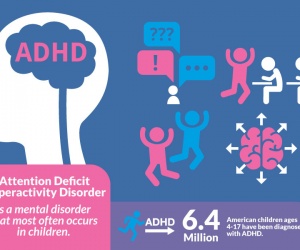ADHD (Imbalanced Behavior)

ADHD (Imbalanced Behavior) : Causes, Effects and Treatment
Life with ADHD has its ups and downs. One day it’s smooth sailing, and the next, it’s rough seas.
ADHD is not a “behavior problem” or “discipline problem”. ADHD is a medical disorder in which genetic, neurological, nutritional and environmental factors imbalance the brain, causing imbalanced behavior.
Big three common ADHD trait:
Inattentive: Unable to put brakes on distractions.
Impulsive: Unable to put brakes on thoughts.
Hyperactive: unable to put brake on acting upon distractions and thoughts.
For the ADHD child it is very difficult to create balance in any activity, behavior and thoughts. They lived in the extreme of any behavior. For example: He or she might be super fun, super frugal, super extravagant or super slothful.
DIAGNOSIS:
ADHD is diagnosed when there is a combination of 6 symptoms from two main groups. According to American Psychiatric Association (2013), these groups relate to “Inattentive” symptoms and “Hyperactive-Impulsive” symptoms.
Within the inattentive group, you might see characteristics like:
- a lack of attention to detail,
- disorganised work and behaviour,
- difficulty listening and concentrating,
- difficulty finishing tasks, distractibility
- losing and forgetting things.
Within the hyperactive-impulsive group of symptoms, you may see:
- fidgeting,
- difficulty sitting still,
- avoiding leisurely play,
- talking excessively,
- difficulty waiting their turn or interrupting others. (American psychiatric association, 2013)
OCCUPATIONAL THERAPY TREATMENT:
The primary goal of Occupational Therapy is to enable people to participate in the activities of everyday life (Wfotorg, 2015).
For kids with ADHD, OT does this in 2 main ways: Remedial and Adaptive strategies.
Remedial strategies aim to restore an impaired capacity.
Inner core strength:
This is not just our ability to do sit-ups. Here we are looking at how kids use their stabiliser muscles. These muscles help them to sit still, breathe effectively and stay in one place for an extended period of time.
Sensory processing:
This skill impacts on how much the sounds, visual aspects and smells in the environment impact your child’s ability to concentrate. Sensory processing also influences how much movement your child needs through the day to get to a “just-right” level to be able to focus. It even makes a difference to how your child sequences and organises their day and how they use their eyes to focus on one place without getting distracted.
Adaptive strategies re-establish routines and habits, or teach skills or strategies to cope with difficulties (Radomski & Trombly Latham, 2013).
Diaries, schedules, reminders, lists and organising tools
One of the most difficult things for children with ADHD/ADD is to remain organised. Difficulties in this area can be disheartening and incredibly frustrating for children and parents alike. It also often has significant negative influences on self-esteem. Your OT can help you to find organising tools that may help your child to reach their potential.
Breaking tasks down into steps
Kids and adults with ADD/ADHD often find it difficult to know where to start, which steps to take next and how to problem solve a task to the point of completion. OTs can help children to practice this skill to improve their ability to implement it in other environments.
“Always remember that pills don’t teach skills.”
Check out these links for relevant information: Speech therapy , occupational therapy, vision therapy
For more details contact
us on 📞9618906780
